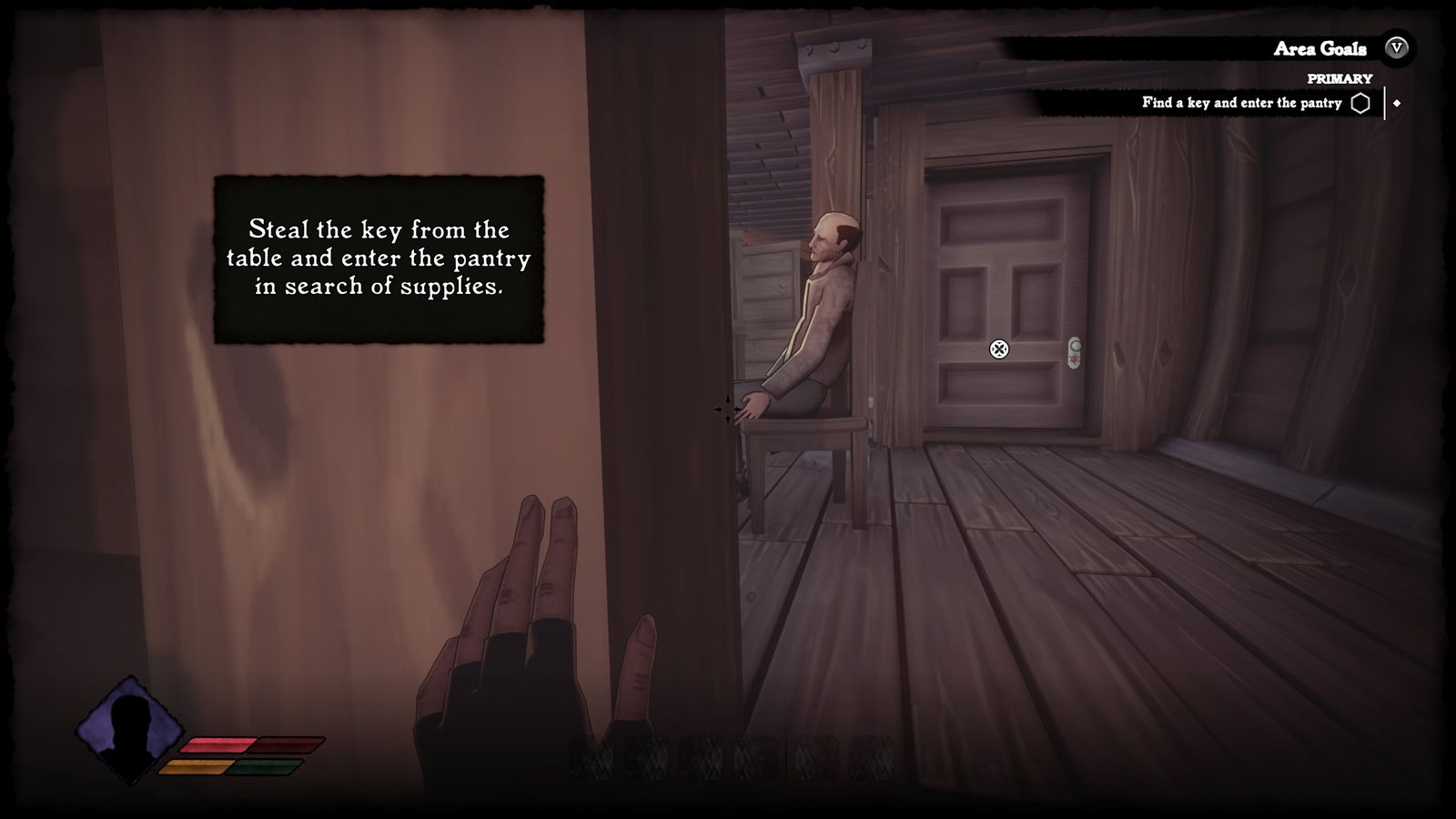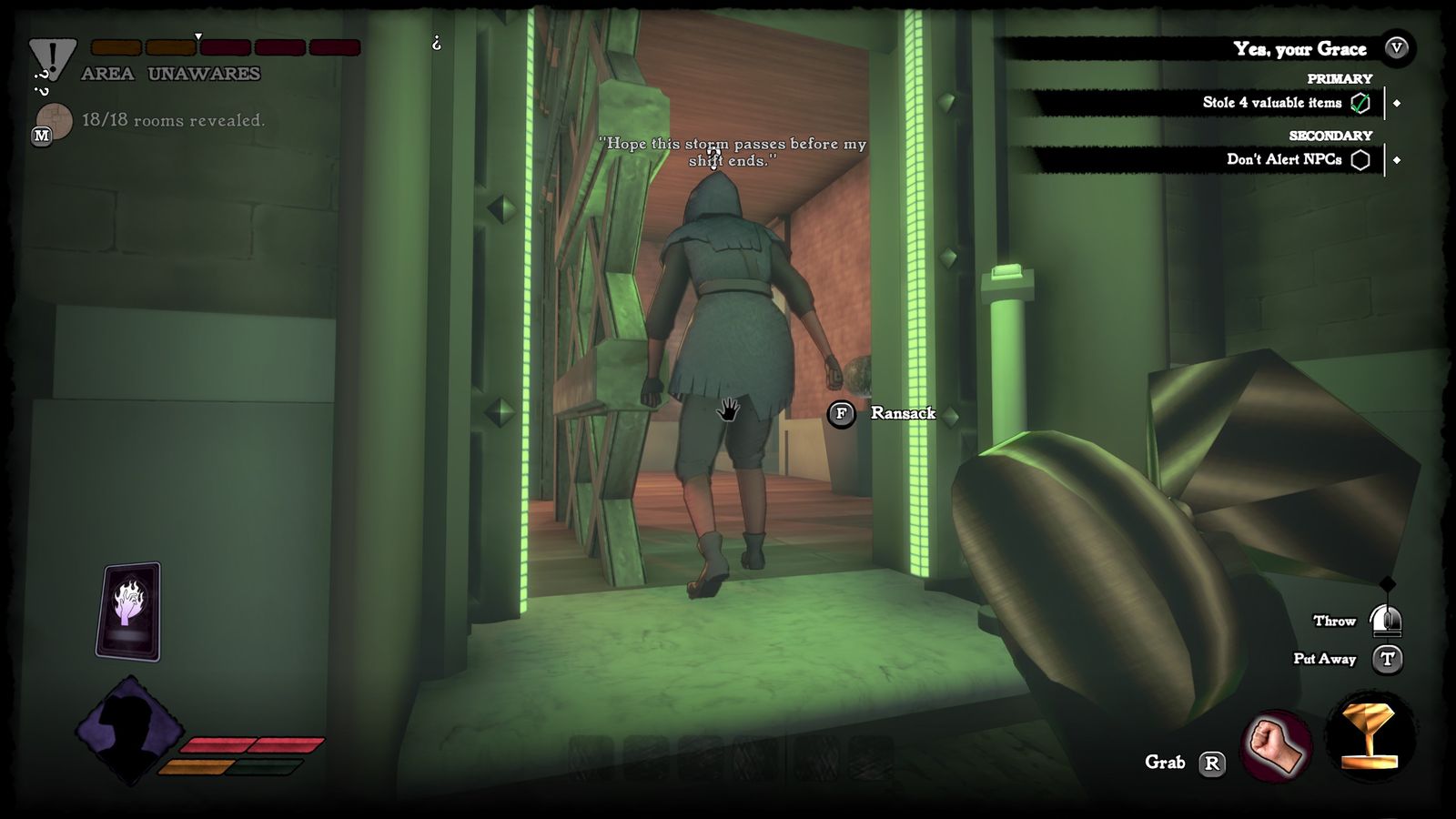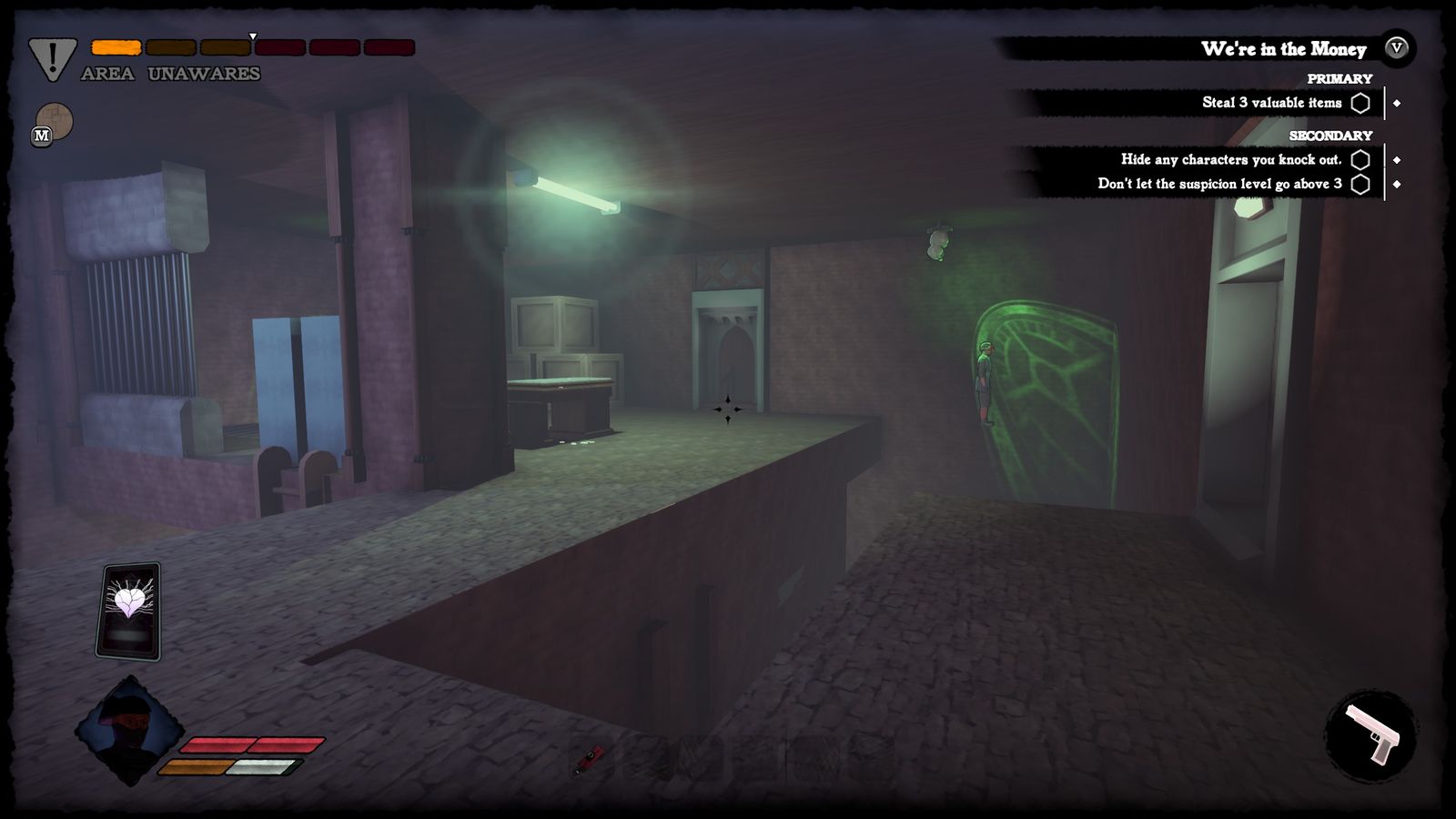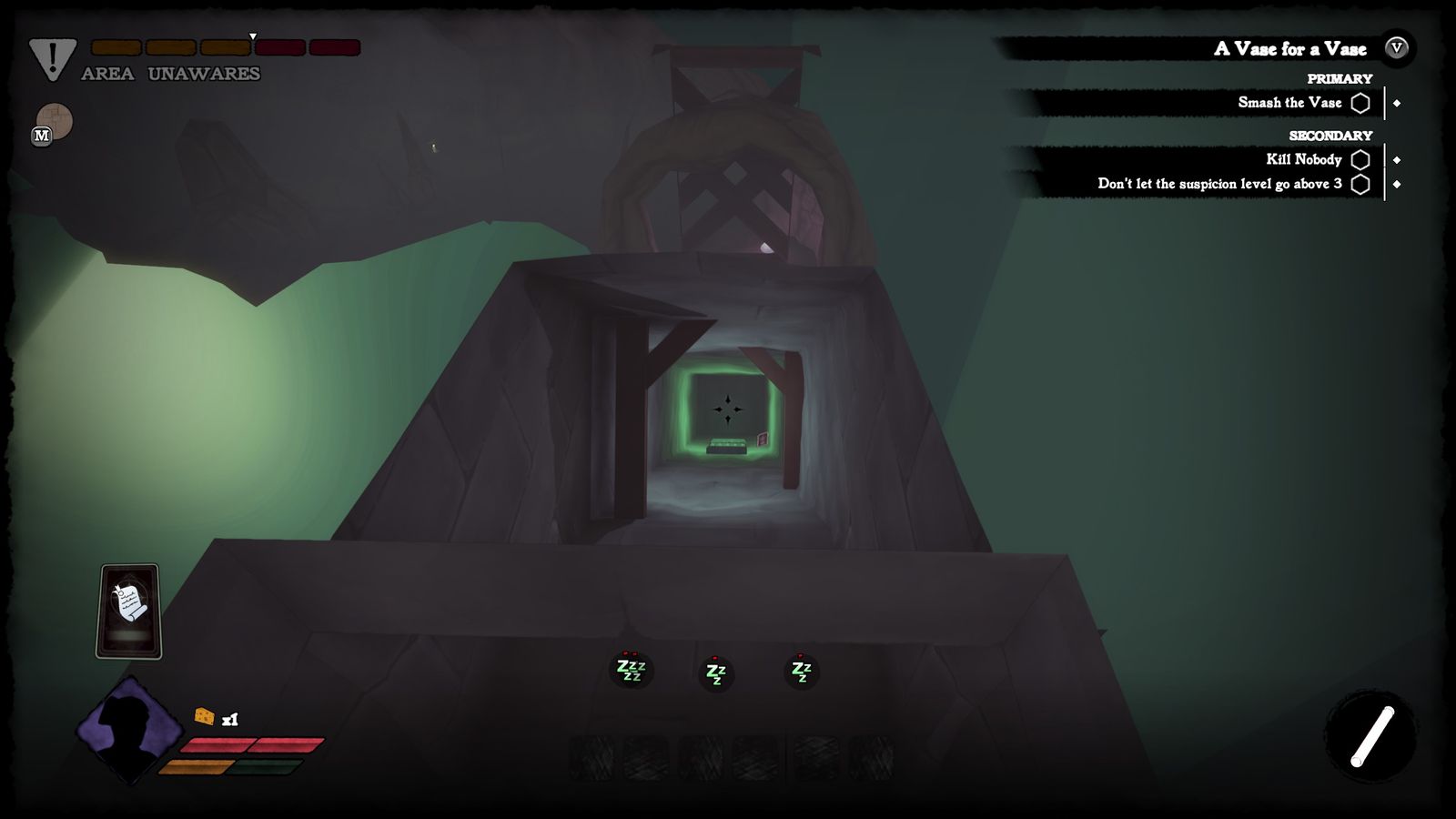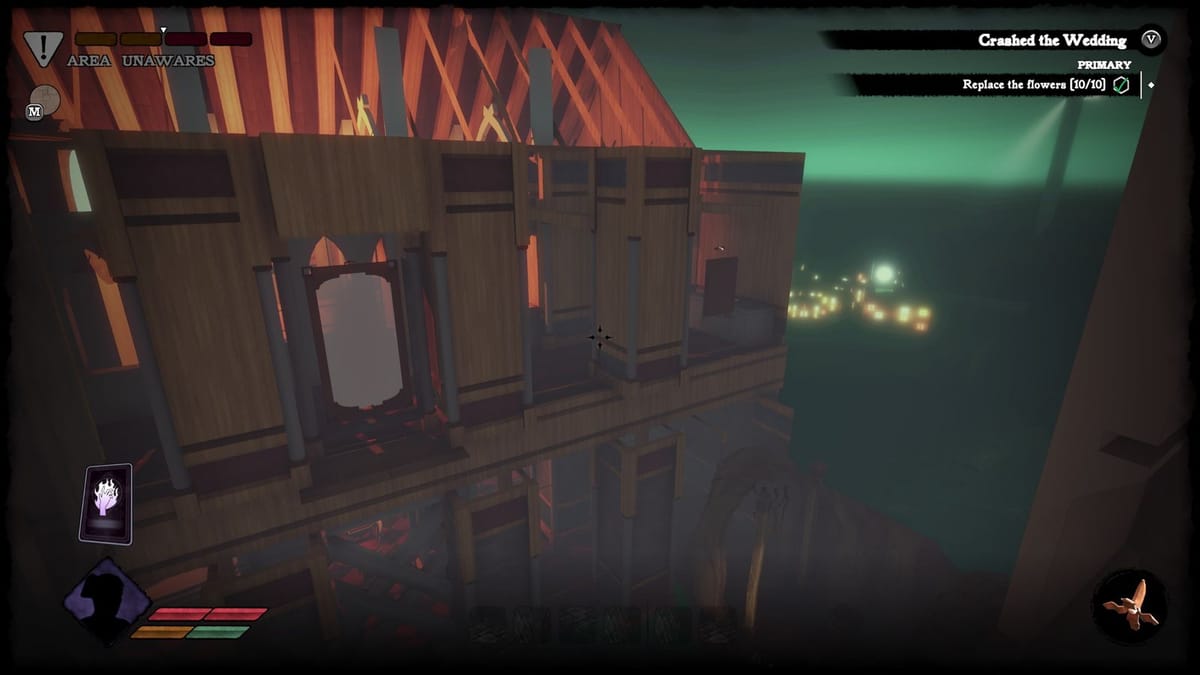
For fans of stealth games, we take what we can get in our dying genre. We lament over beloved series like Thief and Splinter Cell, and appreciate mostly anything new. Abermore tries to fill the gaps that series like Dishonored and Thief left in the stealth genre — games so unique they made their own mark in their respective areas. So Abermore tries something different – it tries to bring these two fan favorites together. And what do we get? A game from Wish.
Now I don’t completely hate this game, let me say that outright – it was pretty fun for the times that it ran smoothly. But for those other times… wait, I’m getting ahead of myself, let’s discuss what Abermore is, at its core. Other than being a Thief or Dishonored-inspired game, it makes its own mark with (what feels at the beginning) a captivating story with detailed world-building already set aside for it. You play as a lowlife, someone who’s stowed away on a ship trying to get to Abermore and set up a new life for themselves. You steal some apples from the crew and head back to your crevice to get some sleep before you dock, upon which you meet the original “Unhanged Man” – someone through history that has changed the fate of Abermore in one way or another. After some dialogue and exposition, this Unhanged Man (known as Pearl) passes you the power and the moniker and sacrifices herself so that you can escape the ship freely. From here, our goal is to save her from the jail in Abermore and set up the greatest heist anyone has ever seen — or so the developers lead us to believe.
The power of the Unhanged Man is one of the most interesting parts of this game; the power to change fate. This power comes through the way of tarot cards which you can pick up through the levels or purchase from Lady Luck. These include becoming invisible, converting glass to air so you can steal what’s behind it, unlocking any lock, or turning an enemy to stone. Unfortunately, either due to her story completing or (highly likely) a bug, I couldn’t speak to Lady Luck anymore to purchase additional tarot cards. Regardless, the tarot card power that the Unhanged Man possesses is one of the most unique things I’ve experienced in a game. It comes upon luck that you stumble on these powers, so you can’t abuse the ones you have.
The other thing that I want to touch on here is the stealth aspect. Although the game suggests that levels are more difficult than others, you’ll find everything is just as simple and easy as the last level you completed. The stealth is so goddamn forgiving that it’s boring. You could be standing in front of any enemy, and if you were in the darkness they wouldn’t see you. Hell, even in the light their cone of vision is so small that you could stand side-by-side with them and they wouldn’t pay any attention to you. It’s as if the game refuses to allow you to make errors.
You spend 18 days developing relationships with the residents of Abermore, completing their missions, and listening to their woes. You need to complete four of their missions, and max out their relationship, to use their skills to assist in the heist. For example, one collaborator, Grace — destined to take on the mantle of the Unhanged Man before you showed up – wants you to prove your worth by completing her “challenging” missions. These missions are suggested to be the toughest in the game, solely because they require to go unseen and (sometimes) not knock out anyone. If the stealth gameplay was any good, this would be a tough challenge. Some other collaborators have even easier missions, such as a chef who wants you to fetch ingredients for him so he can make the best meal that Abermore has to offer, and a mysterious man so entrenched in the idea that there’s a cult in the depths of Abermore that he requires you to prove that this cult exists by stealing additional things while completing other missions.
Abermore is also marketed as a rogue-lite; if you fail a mission, you won’t be able to complete that one again. I had this happen to me when someone wanted me to steal a painting of their rival. I thought I grabbed the right one –- the details all matched up –- but when I got back the client got angry and said I failed. Fair enough. That being said, if you fail a mission — just quit the game altogether and you’ll restart at the beginning of the day, giving you a chance to retry the mission. The only missions that are an exception to this rule are the ones assigned by the collaborators. I suppose the game doesn’t want you to have too much of a difficult time in the final heist so it gives you multiple opportunities to succeed, be it what was intended or not. Here, it would make sense to have a rule built into the game that if the game detects you failed the mission, even if you quit out it would rule that you failed it, regardless.
Each time you complete a mission in Abermore you will awaken in your apartment. The only time there was something to do here was when a client left a gift for me on the windowsill, otherwise, each time you awaken here you just need to head to The Gutter — the bar where all your operations take place. While you walk there, you’ll meet some NPCs who sometimes provide the lore behind Abermore, and (most) other times will just spout nonsense that makes no difference to the game. I found myself just skimming through this area as quickly as possible, running straight to The Gutter so I could get back into the action. The rest of this hub world felt so empty and so out of place in the game, that I don’t really know what its purpose is at all; it doesn’t adapt to the story, every NPC (outside of the collaborators) you meet doesn’t impact the story or the heist in any way, and the ones that recur each time you wake up are so meaningless they might as well not even be there. For example, there’s a guy who swindles you into playing heads or tails. Win or lose, it makes no difference, I’m not sure what his purpose is other than to waste the player’s time and to make this area feel like it’s full of people. Some areas also feel like they’re meant to have a greater purpose to them — like the train station with a locked door, or the hidden room in the bathroom — but they’re never utilized. It feels like these areas were given up and forgotten, which is a theme we will touch on again later.
Once you get into The Gutter you can sell your earnings, pick up new clothes or equipment, and start building relationships with the collaborators. This area felt more lively, with NPCs constantly wanting to share something with you. The dialogue generally kept a steady, gloomy atmosphere that really hammered in the feeling that Abermore was run down on its luck — a place for the misbegotten. Although, sometimes, that feeling was turned on its head, and felt so extremely out of place. One occurrence was when a stranger tries to get onto the train with an oversized sword, and to help them out you lie to the receptionist — telling them that some subsection of some manual proves this stranger can board — then duck out of the conversation immediately after. This is never discussed again, the NPC is never seen or heard of again, and I’m confident this is not a random easter egg. This happens constantly throughout Abermore, that it feels like these bits were just thrown in to, again, add filler in an otherwise empty game.
Each time you do a mission, no matter what, you’ll always be seeing the exact same architecture, the exact same thing over and over. Like a typical rogue-lite, I believe this game is meant to have procedurally-generated locations, but almost every couple of missions it felt like I was experiencing nearly the exact same layout. The aesthetic also stayed the same throughout the entire game too — each mission tended to feel like I was just spawning in from a different part of a very large house, with only a few rooms changing upon exploration. Of course, a quick look at the map and it was clear that was a lie, but with such a generic art style and room design it might as well be true. I can count three times where I saw a different styled location — the first being the ship you begin the game on, the second being a church where you must sabotage a wedding (a mission that, at neck-breaking speeds, quickly goes back to the same generic room design), and the final level, which shows a throne and a few pews placed in rows in front of it. That’s it. Again, we’ve got that recurring theme again – where the game feels like it was half-assed to completion.
Now the biggest example that gives rise to this repeated theme of half-assedness is the disappointing attitude of “tell, don’t show” that the developers are cuckoo for implementing. Let me ask you some questions. If the game presented a priest whose text exposition said he was surrounded by a crowd — would you expect to see a crowd? If you’re taken to a wedding, and the client asks you to sit down with her after you’ve sabotaged it — would you expect to see how the wedding goes down? In the final mission, if the collaborators you hired promised to escort you on a train that would see a backdrop of a prison you just blew up — would you expect to see an explosion? If you’re anyone but Four Circle Interactive, your answer would be “yes!”. Everything interesting or spectacular you think you will see or experience in this game, won’t happen. The only thing you will see is the most rudimentary stealth gameplay known to a game, nothing more.
Immediately after realizing that I was experiencing the same BS all the way through each mission, I started to think, is this even finished? Well, while it has a full release on Steam, that couldn’t be farther from the truth. This game was nearly on par with being as buggy as Cyberpunk 2077. This next bit is going to be easier as bullet points, so here are all bugs I experienced in the game:
- NPCs would spawn in each other.
- If you knocked an enemy out and threw them close to a wall they couldn’t wake up.
- If they ran to record a disturbance, which ultimately raises the difficulty, they would tend to get stuck in a loop-animation.
- Music would stop playing if you stayed on a dialogue screen for too long.
- Some questlines are bugged so that you can’t finish them, and you can’t use them for the final mission.
- Areas weren’t finished.
- An NPC spawned in the air and stayed there.
- The sewer systems were always bugged – letting you go out of bounds and see through walls.
- Vents would push you out of bounds, nearly soft-locking that mission because it was so extremely difficult to fall back in bounds.
- Loading screen crashes.
- Extremely unoptimized, with frame rates going from 144 to 60fps even on a 3060 Ti.
- NPCs walk at 20-30fps, while the rest of the game runs at a different framerate.
- If you carry an item out of a level it would get added on top of another item, which means you might sell the wrong item because it looks like something else entirely.
- Items would stack in your chest inventory every time you purchase from a vendor, regardless if they’re the same item or not.
- Items would sometimes stay on your person if you climbed something, other times it would just drop.
- Spawning in front of an enemy, causing them to freak out and alert the guards, instead of spawning somewhere safe and away from any enemies.
- Sometimes text would pop up to the side of the screen, so you can read a transcript of the dialogue that you had with an NPC, but that only happened when you spoke to them after completing their final mission.
- Doors have such huge hitboxes that they can prevent projectiles from passing by them.
- Using the feather-foot tarot card muffed all audio, even after it was used up.
- Lights would sometimes disappear in a room if you looked at a certain part of a room.
- If you purchase a heap of cards from Lady Luck, and you don’t have the space to store each one, they just get stacked on top of each other so you can effectively have as many as you want.
With all these bugs, it makes me think; was this game even playtested? It feels rushed, incomplete, like it was given up halfway through development, but they had a deadline and a game to be published — so no matter what, it had to be listed on Steam. Hell, I’m so conflicted I’m not even sure that the game was meant to be completed. The last mission was so bugged I almost couldn’t access it; I didn’t have any missions to do, but thankfully the devs implemented the ability to sleep in your apartment to skip through the days. Ok, so we’re good right? Almost got soft-locked, but clearly, we didn’t. Again, I try loading into the final mission: game crashed. I started thinking if this game was cursed. Surely not, let’s try that again. I finally spawned into the level, played through a bit of it, then the bolt from my crossbow got caught on a door — even though I was clearly aiming at the target. This alerted the target and the guards were after me. So hitbox issues… argh… let’s just keep going. I tried to play through this bit because I was so done with reloading at this point, but the guards caught up to me and killed me. Then, Lady Luck shined on me and gave me a second chance. Great, let’s finally finish this mission. However, for some reason, I’m spawned right in front of Pearl. So I’m thinking: job’s done — I have the HVT and now I just need to escape. I slide through the final vent, and the game boots me out of bounds — now I’m stuck on top of the vent. I spend five, maybe 10 minutes here trying to throw myself back in bounds, and I succeed thankfully, so I extract, and finally — who knows how long later, I’ve finished the game. At this point, the only thing I can think of is one question — did the playtesters, if they were there, not even get this far into the game before giving up? Honestly, after that kind of experience, who could blame them?
With all its bugs, all its faults, Abermore is the last thing I will recommend to anyone wanting to play a Thief or Dishonored clone. There are far better games out there, far better experiences to immerse yourself in. The only thing I have planned to do with this game is to uninstall it and shelve it so far away in my digital library that it’ll never see the light of a computer screen again. This is not a game that is finished, not a game that feels playtested, and not a game that you should spend any of your money on.
Abermore
Terrible
Abermore is an immense disappointment. The bugs and glitches can be cataloged so extremely clearly that it’s incredible that this game even got released, let alone past playtesting. Hell, was it playtested? Why did this game get released even if it wasn’t finished? These questions stuck in my mind as I played through this dumpster fire. Maybe this game will see all its bugs patched? Sure, but that doesn’t mean that there’s nearly enough interesting, let alone unique, content throughout the levels to warrant any recommendation from me.
Pros
- The tarot card system is unique, and makes Abermore stand out from a lot of other fantasy stealth games
Cons
- Stealth is so pathetically easy that there’s barely any challenge
- Levels feel lackluster and unfinished, as if barely any playtesting went into Abermore
- Art style is boring and assets are reused so much through the entire game that I experienced the same rooms more than I experienced actual unique gameplay content
- A catalog of bugs and glitches, on par with Cyberpunk 2077

